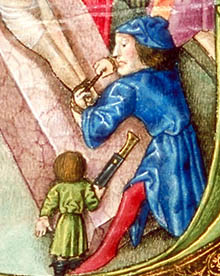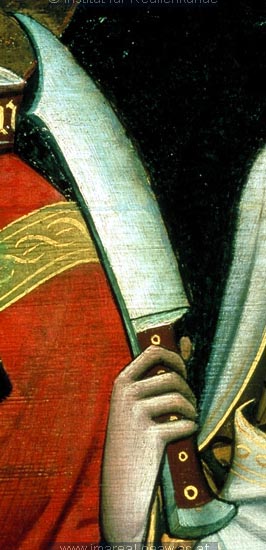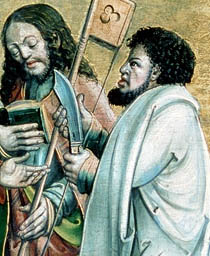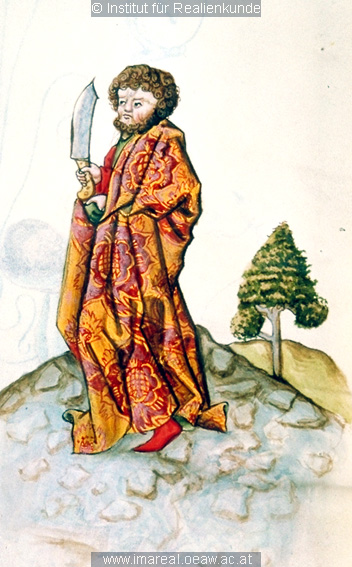| Author |
Message |
Sean Flynt

|
 Posted: Mon 26 Nov, 2007 1:36 pm Post subject: Medieval Knife Questions Posted: Mon 26 Nov, 2007 1:36 pm Post subject: Medieval Knife Questions |
 |
|
Poor St. Bartholomew....skinned alive (he's the patron saint of tanners--no joke). Hl. Bartolomäus is almost invariably depicted (ca. 1400-1550) holding a contemporary version of the instrument of his execution--a large, clip-point knife with scale grip. See the image below of St. B. testing the edge with his thumb--at least he had a sense of humor about it.
I'm going to make one of these (to me) very attractive knives and have a few questions:
I know generally how tubular rivets are made/set, but I have no hands-on experience. For this project, should I drill the main hole, then countersink a slightly larger hole for the peened edges of the tube to rest in? Tool tips?
Steel or brass tubing for the rivets? I assume the brass would be much easier/neater to work with since it's so easily annealed. But is one material more historically appropriate than the other?
If the tubular rivets don't work out for some reason, is it historically appropriate to use solid rivets?
One of the images below offers a clue about the carriage and purpose of such knives. See that little Torturer's Apprentice? He's handing Daddy one of these knives in its sheath with a byknife or pricker. That treatment suggests to me that this is just a general purpose knife--a Bauernwehr or Hauswehr. Is that right? Am I justified, historically, in calling my project a Bauernwehr? Or is this something else--a form of butcher's knife that the medieval Average Joe would immediately recognize as distinct from his everyday knife?
Should the scabbard/sheath be of thick leather or more like a sword scabbard--thin leather over wood core. The aforementioned image of the byknife suggests the latter, doesn't it? Maybe both methods are appropriate.
Most of these knives clearly have bolsters, but in some cases the wood scales just seem to bevel down to the blade. I don't mind making a sandwich-type bolster, but if that isn't an historically accurate method I'd rather stick to the all-wood grip if that would be more accurate.
Any general suggestions?
Thanks!
 Attachment: 57.7 KB Attachment: 57.7 KB

 Attachment: 71.44 KB Attachment: 71.44 KB

 Attachment: 75.54 KB Attachment: 75.54 KB

 Attachment: 68.47 KB Attachment: 68.47 KB

 Attachment: 130.64 KB Attachment: 130.64 KB

 Attachment: 87.97 KB Attachment: 87.97 KB

 Attachment: 79.27 KB Attachment: 79.27 KB

-Sean
Author of the Little Hammer novel
https://www.amazon.com/Little-Hammer-Sean-Flynt/dp/B08XN7HZ82/ref=sr_1_1?dchild=1&keywords=little+hammer+book&qid=1627482034&sr=8-1
|
|
   |
 |
|
Al Muckart
|
 Posted: Mon 26 Nov, 2007 5:15 pm Post subject: Posted: Mon 26 Nov, 2007 5:15 pm Post subject: |
 |
|
Hi Sean,
For an overview of construction I can't recommend Knives and Scabbards enough. It was originally published by the Museum of London, and was republished by Boydell press. Amazon have it, as do Oxbow Books (my preferred supplier because they do a lot to make sure that books of interest to medievalists are kept in print). Most of your questions should be answered in there.
Rivet-wise either solid or tubular are found. This may be dependent on time, place and style of knife though.
Scabbard-wise you're probably looking at two layers of thin-ish 1.5mm or so leather. The inner one grain side in and the outer one grain side out.
I hope that helps a bit.
--
Al.
http://wherearetheelves.net
|
|
   |
 |
Sean Flynt

|
|
   |
 |
James Barker

Location: Ashburn VA Joined: 20 Apr 2005
Posts: 365
|
 Posted: Tue 27 Nov, 2007 7:45 am Post subject: Posted: Tue 27 Nov, 2007 7:45 am Post subject: |
 |
|
Al has the right of it but I would add solid wire used as a rivet like the knives from Historic Enterprises have seem far more common in museums and I don't think Knives and Scabbards has one hollow tube rivet in it. Also note that Knives and Scabbards mostly only covers small knives and not the lager carving or skinning knives like you are looking for Sean but the technology is the same.
James Barker
Historic Life http://www.historiclife.com/index.html
Archer in La Belle Compagnie http://www.labelle.org/
|
|
   |
 |
Sean Flynt

|
 Posted: Tue 27 Nov, 2007 7:55 am Post subject: Posted: Tue 27 Nov, 2007 7:55 am Post subject: |
 |
|
| James Barker wrote: | | Al has the right of it but I would add solid wire used as a rivet like the knives from Historic Enterprises have seem far more common in museums and I don't think Knives and Scabbards has one hollow tube rivet in it. Also note that Knives and Scabbards mostly only covers small knives and not the lager carving or skinning knives like you are looking for Sean but the technology is the same. |
Hmmm...those are just pins, right? My tang is already pierced for pins. Would those be peened or just inserted and cut off flush with the scale?
-Sean
Author of the Little Hammer novel
https://www.amazon.com/Little-Hammer-Sean-Flynt/dp/B08XN7HZ82/ref=sr_1_1?dchild=1&keywords=little+hammer+book&qid=1627482034&sr=8-1
|
|
   |
 |
James Barker

Location: Ashburn VA Joined: 20 Apr 2005
Posts: 365
|
|
   |
 |
Sean Flynt

|
|
   |
 |
|
Mark Shier
Industry Professional
|
 Posted: Tue 27 Nov, 2007 4:48 pm Post subject: tube rivets Posted: Tue 27 Nov, 2007 4:48 pm Post subject: tube rivets |
 |
|
|
There are tube rivets in a 15C knife in my collection. The table on page 26 of Knives and Scabbards shows 5 knives with tube rivets.
|
|
  |
 |
|
Al Muckart
|
 Posted: Tue 27 Nov, 2007 4:56 pm Post subject: Posted: Tue 27 Nov, 2007 4:56 pm Post subject: |
 |
|
| Sean Flynt wrote: |
Hmmm...those are just pins, right? My tang is already pierced for pins. Would those be peened or just inserted and cut off flush with the scale? |
Both I would have thought. Peened into a gentle countersink and then ground flush with the handle.
I don't know if they did it in period, but it would seem resonable to glue the scales on with some hide glue too.
--
Al.
http://wherearetheelves.net
|
|
   |
 |
Leo Todeschini
Industry Professional

|
 Posted: Tue 27 Nov, 2007 8:09 pm Post subject: Posted: Tue 27 Nov, 2007 8:09 pm Post subject: |
 |
|
I would agree that there are quite a few knives in knives and scabbards that have hollow rivets, but more with solid. In both cases a large number were in brass/bronze/latten as it is easy to work especially for hollow ones.
I use both and both are easy to do. For solid there is no need for any countersink, just leave about 0.5mm out each side and peen them over with the rounded end of a ball pein hammer to mushroom out the top and file/sand off any upstand. If using bone scales a small countersink helps/
If using tubular, a small countersink helps, and I make a small punch a little like those for setting eyes in fabric or leather.
Abit of practice will havinbg you doing them neatly and quickly.
Tod
www.todsworkshop.com
www.todcutler.com
www.instagram.com/todsworkshop
https://www.facebook.com/TodsWorkshop
www.youtube.com/user/todsstuff1
|
|
   |
 |
Sean Flynt

|
|
   |
 |
James Barker

Location: Ashburn VA Joined: 20 Apr 2005
Posts: 365
|
|
   |
 |
|
Johan S. Moen
Location: Kristiansand, Norway Joined: 26 Jan 2004
Posts: 259
|
 Posted: Wed 28 Nov, 2007 7:42 am Post subject: Posted: Wed 28 Nov, 2007 7:42 am Post subject: |
 |
|
| James Barker wrote: | Tod and Mark
How do you guys make the tubular rivets? Do you start with a brass tube from a hobby supplier? |
I'm neither Tod or Mark, but I'll answer anyway  . I usually use brass tubing as it is easy to get hold of, and it saves some work. I have also made some tubular rivets from brass sheet, thickness ranging from 0,5 to 1 mm. The 0,5 mm stuff works well, the 1 mm can be a bit tricky to get to shape. When using sheet i use flat and needle-nose pliers to curve it around a rod of appropriate thickness. One should maybe braze or solder the joint, but I can't do that in my apartement... You can hide the joint through some careful peening anyway. . I usually use brass tubing as it is easy to get hold of, and it saves some work. I have also made some tubular rivets from brass sheet, thickness ranging from 0,5 to 1 mm. The 0,5 mm stuff works well, the 1 mm can be a bit tricky to get to shape. When using sheet i use flat and needle-nose pliers to curve it around a rod of appropriate thickness. One should maybe braze or solder the joint, but I can't do that in my apartement... You can hide the joint through some careful peening anyway.
Johan Schubert Moen
|
|
  |
 |
Sean Flynt

|
|
   |
 |
James Barker

Location: Ashburn VA Joined: 20 Apr 2005
Posts: 365
|
 Posted: Wed 28 Nov, 2007 9:26 am Post subject: Posted: Wed 28 Nov, 2007 9:26 am Post subject: |
 |
|
You know I looked at that knife and even have 3 images of it on my site and I didn't realize until now that those were large hollow rivets.
James Barker
Historic Life http://www.historiclife.com/index.html
Archer in La Belle Compagnie http://www.labelle.org/
|
|
   |
 |
Sean Flynt

|
|
   |
 |
Leo Todeschini
Industry Professional

|
 Posted: Wed 28 Nov, 2007 8:09 pm Post subject: Posted: Wed 28 Nov, 2007 8:09 pm Post subject: |
 |
|
Tubular rivets were fitted a bit like scroll pins and then flared out; again I don't bother with a countersink unless into bone. To my knowledge they were not soldered and usually overlapped like a scroll pin; the ones on the dagger are unusually neat.
You can slit a length of KandS brass or copper tube and use that which will come out correct, you can use it unslit which will come out close to correct and is easy or you can open the jaws of your vice a touch, place a long piece of flat strip on the gap and tap into it with a cold chisel to create a 'U' holding the long end then rotate the U around and tap the edges down with a pin hammer to make something close to round and this would be spot on. They were rarely better than that; made by craftsmen yes, but mass produced for profit most of the time regardless.
I guess once you have cut your pin down you could tap it through a hole in a plate to round it more.
Have fun
Tod
www.todsworkshop.com
www.todcutler.com
www.instagram.com/todsworkshop
https://www.facebook.com/TodsWorkshop
www.youtube.com/user/todsstuff1
|
|
   |
 |
D. Austin
Industry Professional

Location: Melbourne, Australia Joined: 20 Sep 2007
Posts: 208
|
 Posted: Thu 29 Nov, 2007 3:59 pm Post subject: Posted: Thu 29 Nov, 2007 3:59 pm Post subject: |
 |
|
Hi Sean,
Not sure if it helps but I found this photo. It's not exactly medieval (circa 1650 apparently) but it looks like what you are after and was described by the auction house as a german hunting knife.
Darren.
 Attachment: 25.06 KB Attachment: 25.06 KB
[ Download ]
|
|
  |
 |
|
Ken Speed
|
 Posted: Thu 29 Nov, 2007 4:08 pm Post subject: Posted: Thu 29 Nov, 2007 4:08 pm Post subject: |
 |
|
Sean,
If you want to get a knife very similar to the ones you have shown us as opposed to making one I suggest you look at some of the custom knife-makers on the web who are making Hudson's Bay Knives. These are essentially big heavy bladed butcher knives that were originally sold or traded for skinning buffalo.
Ken
|
|
  |
 |
Michael Ekelmann

|
 Posted: Thu 29 Nov, 2007 4:47 pm Post subject: Posted: Thu 29 Nov, 2007 4:47 pm Post subject: |
 |
|
| Ken Speed wrote: | Sean,
If you want to get a knife very similar to the ones you have shown us as opposed to making one I suggest you look at some of the custom knife-makers on the web who are making Hudson's Bay Knives. These are essentially big heavy bladed butcher knives that were originally sold or traded for skinning buffalo.
Ken |
Also,
Look on ebay for Old Hickory Butcher Knives or Antique Butcher Knives. I picked up an Old Hickory butcher knife that has the same blade profile as the skinning knives shown in the period illustrations. I think it cost me about 15 USD after shipping.
Take this one for example
http://cgi.ebay.com/ANTIQUE-PRIMITIVE-HAND-FO...dZViewItem
Cheers,
Michael
“Men prefer to fight with swords, so they can see each other's eyes!" Sean Connery as Mulay Hamid El Raisuli in The Wind and the Lion
|
|
  |
 |
|
|

